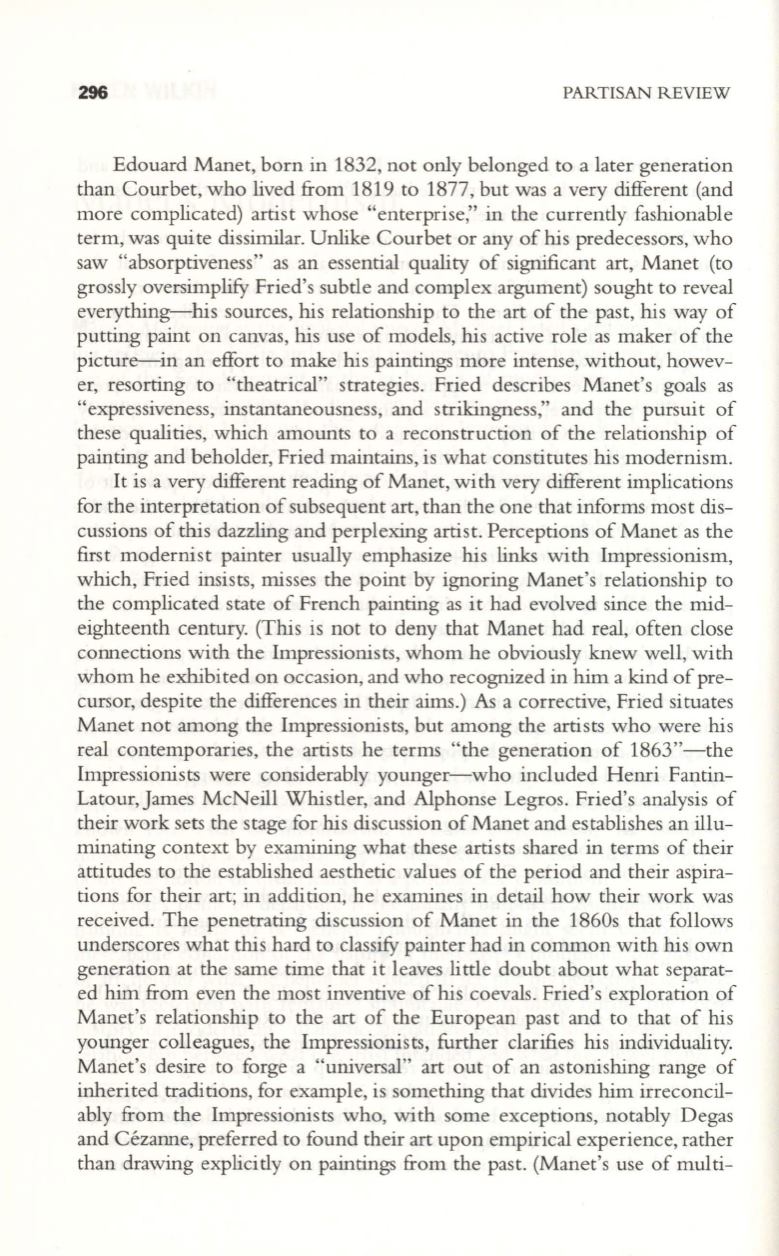
296
PARTISAN REVIEW
Edouard Manet, born in 1832, not only belonged to a later generation
than Courbet, who lived from 1819 to 1877, but was a very different (and
more complicated) artist whose "enterprise," in the currently fashionable
term, was quite dissimilar. Unlike Courbet or any of his predecessors, who
saw "absorptiveness" as an essential quality of significant art, Manet (to
grossly oversimplify Fried's subtle and complex argument) sought to reveal
everything-his sources, his relationship to the art of the past, his way of
putting paint on canvas, his use of models, his active role as maker of the
picture--in an effort to make his paintings more intense, without, howev–
er, resorting to "theatrical" strategies. Fried describes Manet's goals as
"expressiveness, instantaneousness, and strikingness," and the pursuit of
these qualities, which amounts to a reconstruction of the relationship of
painting and beholder, Fried maintains, is what constitutes his modernism.
It
is a very different reading of Manet, with very different implications
for the interpretation of subsequent art, than the one that informs most dis–
cussions of this dazzling and perplexing artist. Perceptions of Manet as the
first modernist painter usually emphasize his links with Impressionism,
which, Fried insists, misses the point by ignoring Manet's relationship to
the complicated state of French painting as it had evolved since the mid–
eighteenth century. (This is not to deny that Manet had real, often close
connections with the Impressionists, whom he obviously knew well, with
whom he exhibited on occasion, and who recognized in him a kind of pre–
cursor, despite the differences in their aims.) As a corrective, Fried situates
Manet not among the Impressionists, but among the artists who were his
real contemporaries, the artists he terms "the generation of 1863"-the
Impressionists were considerably younger-who included Henri Fantin–
Latour,James McNeill Whistler, and Alphonse Legros. Fried's analysis of
their work sets the stage for his discussion of Manet and establishes an illu–
minating context by examining what these artists shared in terms of their
attitudes to the established aesthetic values of the period and their aspira–
tions for their art; in addition, he examines in detail how their work was
received. The penetrating discussion of Manet in the 1860s that follows
underscores what this hard to classify painter had
in
common with his own
generation at the same time that it leaves little doubt about what separat–
ed him from even the most inventive of his coevals. Fried's exploration of
Manet's relationship to the art of the European past and to that of his
younger colleagues, the Impressionists, further clarifies his individuality.
Manet's desire to forge a "universal" art out of an astonishing range of
inherited traditions, for example, is something that divides him irreconcil–
ably from the Impressionists who, with some exceptions, notably Degas
and Cezanne, preferred to found their art upon empirical experience, rather
than drawing explicitly on paintings from the past. (Manet's use of multi-


